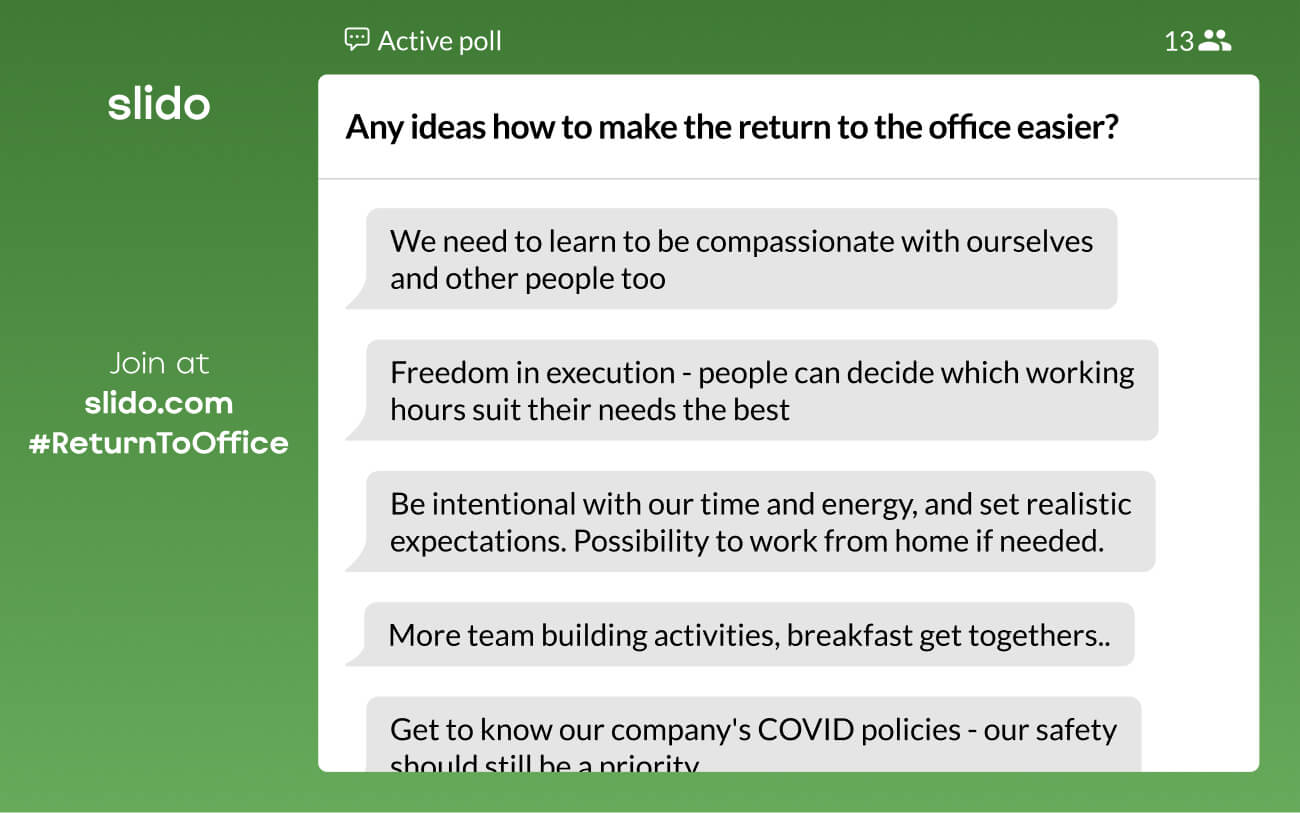After more than two years of working from home, companies are increasingly changing their remote work policies, with the return to the office now in full swing.
Fewer than 8% of Americans now work totally from home, according to a survey from the Bureau of Labor Statistics, down from 35% at the start of the pandemic in May 2020.
Many workplaces are now in the process of figuring out how to motivate employees to come back into the office in a hybrid world – while keeping levels of trust and morale high.
But it’s about a lot more than providing fancy coffee and biscuits. Before you think about making the office space worth the commute, your team’s voices, views and ideas deserve to be heard, as your company shapes its “new normal”.
By including the voices of your team in the discussion, a more harmonious working environment will be encouraged. But how do you facilitate these conversations?
If this is a task you’re facing, then read on, because Slido has four suggestions on ways to communicate with your team about going back into the office.
#1. Have an open and honest conversation about the return to work
Employees will be curious about what’s going to change now that they’re being asked to come back in.
To address their burning questions, organize a transparent ‘Ask Me Anything’ (AMA) session, and let your team submit their queries in advance.
Tools such as Slido offer a safe avenue where employees can have their say anonymously, via a Live Q&A, without fearing that they’ll be in the spotlight.
Everyone has a chance to submit or upvote existing questions so that the most burning issues are highlighted.

These insights will give leadership a chance to identify what the key issues are that need to be discussed in the AMA. It will also give them time to prepare answers to these important questions with proper thinking time.
#2. Shape the new ways of working together by including employees’ opinions on the return to work
Let your team share their feelings on the return to the office, so you can identify what key areas you need to provide support with.
The misconception is that companies are going ‘back to normal’ now, when in reality the world has changed forever – and businesses need to recognize that.
Invite your team to be part of a change for the better in the workplace. Let them explain their work preferences, the hours that suit them best, and what it is they need exactly to work well in a hybrid world.
To kick off that conversation, we recommend running a survey with your team. You can start with a quick Rating poll, or pulse check, where staff can vote on how they’re feeling on a scale of up to ten.
Then, they can elaborate on their thoughts via an Open text poll. You can also run the survey asynchronously, so your team can fill it out in their own time regardless of the time zones.

After collecting the input, make sure to dedicate some time to understanding the challenges and suggestions laid out by your team. This will will help you to decide on action points, as well as communicate the next steps in addressing them.
#3. Adopt the ‘freedom and responsibility’ approach
These days, the traditional 9-5 model just doesn’t cut it anymore. The way that we work has been forever changed, and the return to the office needs to reflect that.
Teams may be scattered across different time zones, while employees are busy juggling their workloads with childcare and other responsibilities.
Although your team may now be required to do certain days in the office, they’ll appreciate you demonstrating your trust in them by letting them choose the hours that work best for them.
That trust will pay forward in the workplace, too. The Harvard Business Review found that high-trust companies reported 50% higher productivity, 74% less stress, and 40% less burnout.
At Slido, we live and breathe ‘Freedom and Responsibility’ when it comes to work. So much so that it’s written into the Slido Culture Code.

Every Slido employee has the autonomy to choose the schedule that best fits their work-life balance. It’s all about looking for results, and not presenteeism.
#4. Highlight the importance of belonging
One of the most important reasons for heading back into the office is the face-to-face interaction it provides.
However, only 28% of businesses have agreed with their staff on when – and why – hybrid workers should be heading into the office, according to Microsoft’s Work Trend Index 2022.
And it’s no surprise then, that Microsoft also found that 38% of hybrid workers say their biggest challenge is knowing when to work in the office, and when remotely.
If staff are heading in to sit and type without any collaboration happening, the act of going into the office isn’t being utilized to its full extent.
Instead, foster that sense of community and belonging by establishing ‘anchor days’.
These are times that valuable connections and interactions will happen: during team breakfasts, lunches, brainstorming sessions, or workshops.
Hybrid workers will start to feel part of the bigger picture when they are having these in-person exchanges again – which are simply not possible when working remotely.
Every company is different, and each department functions to its own specifics, but by focusing on building trust and transparency into your organization, your team’s return to the office will be a much more comfortable process for everyone.
Ready to face the office?
Even with an open and transparent dialogue, a team’s return to the office is a tightrope walk. While there is no one-size-fits-all solution, we encourage you to try and figure out what works best for you and your team.
At Slido, we’re ready to help your company achieve that. Contact us and we’ll be happy to find the best solution for you.




